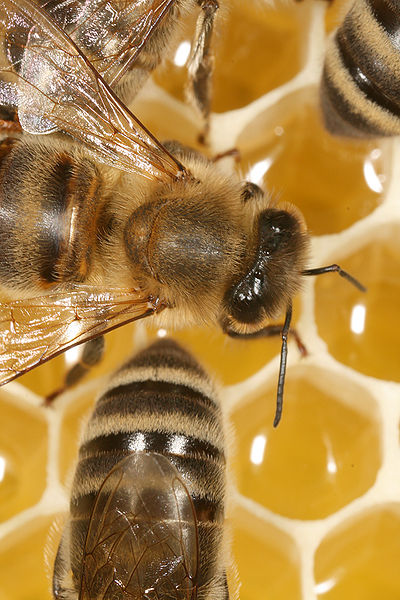Using Honey as the First Chemical Weapon
Interview with
We've heard how nature has informed our understanding of pain pathways and perception. But how exactly are these signals transmitted?
Also with us this week is Fran Ashcroft. She's Professor of Physiology at Oxford University and the author of several popular science books, including recently, The Spark of Life, which answers questions like why does an electric eel not shock  itself?
itself?
Hannah - So, Fran, you're the Professor of Physiology at Oxford University and you're also the author of several popular science books including most recently, The Spark of Life which answers questions such as, why does an electric eel not shock itself? So, ion channels, I believe that you've got one particular ion channel which is historically one of your favourites.
Fran - Well, my favourite ion channel is of course the one that I personally work on. But I think the one that you're referring to is one of my favourite stories. This is an ion channel which is involved in the sodium channel which is involved in the conduction of nerve impulses. As we've already heard, all sorts of chemicals can interact with ion channels. There is one which is known as grayanotoxin which is found in the pollen of a certain species of rhododendron which is found on the Black Sea. Its effects are best describe perhaps by Xenophon in 400 BC when he explains how his soldiers eat of the honey that was made from the pollen of these rhododendrons. And found themselves with lots of diarrhoea and purging, and vomiting, and having convulsions. He has this marvellous phrase that they all lay on the ground in a state of great dejection. Fortunately, they recovered and nothing really much happened for another 200 years until Pompey was invading that area. The Greeks remembered this story of Xenophon's and they collected the honey, and strewed it in the path of the oncoming troupes who at it, became incapacitated.
Hannah - So, the troops took a little break ate the honey that had been there as a honey trap and...
Fran - And were incapacitated and were then decapitated. So, this was perhaps one of the earliest forms of chemical warfare and I shouldn't say this, but at the same time, it's another example of the fact that one should not trust Greeks bearing gifts.
Hannah - And what was this toxin actually doing to the ion channels then?
Fran - What the toxin does is it holds the sodium channels open. We've heard already about toxins which act by blocking ion channel function. This one acts by enhancing the activity of this particular ion channel.
Hannah - And it had this wide ranging number of effects on the digestive system and then of the eventual decapitation of the soldiers.
Fran - There was another coda to this story really and that is, that these days, of course the rhododendrons are still there, the honey is still produced by the local bees. The honey's blended in with many other honeys. So, the toxin is diluted out. But in that local area, you can actually get the honey that is made specifically from this particular species of rhododendron. It has a local vogue as an aphrodisiac which is rather unfortunate and there are even stories today - you can read them, very recent papers in the scientific journals - of men who have taken some of these and ended up in a hospital rather acutely ill.
Hannah - That's an interesting story. So, you mentioned that you work on a similar type of ion channel now.
Fran - It's slightly different. The ion channel that I'm very interested in is one that's found in the cells of the pancreas. This channel is involved in the regulation of insulin secretion. So, as most people know insulin is the hormone that controls your blood sugar level and if you don't have enough, you get diabetes. I've been very interested in trying to understand what is the cause of diabetes. What we found was that when this ion channel is open, insulin is not released and when the ion channel is closed, insulin is released. I know that sounds counter intuitive, but the insulin is not going through the channel. The closing of the channel just triggers a whole series of events. What's been particularly exciting for me is that a colleague of mine recently found that mutations in this particular gene cause diabetes at birth. We've been able then to take that forward and show how this happens. What's been really extraordinary is that children with this disease were always treated by insulin injections. But when we recognised that they had a problem with their ion channels, we knew of a drug which shut the open channels. And so, we were able to transfer the patients from insulin injections onto drug therapy. And of course, that's transformed their lives. It's made their blood sugar control very much better and it's also, they prefer not having injections. You can imagine, it's difficult to inject a 3-month-old baby. I should just mention that this is a very rare disease. So, it's very unlikely too that most people who've got diabetes when they were young - it's only found in patients who have diabetes before the age of 6 months.
- Previous Nerves Signals and Light
- Next How Do Nerve Cells Signal Pain?










Comments
Add a comment